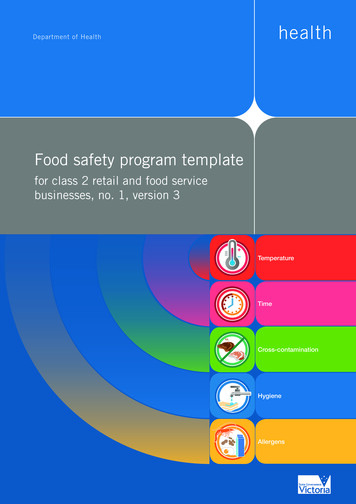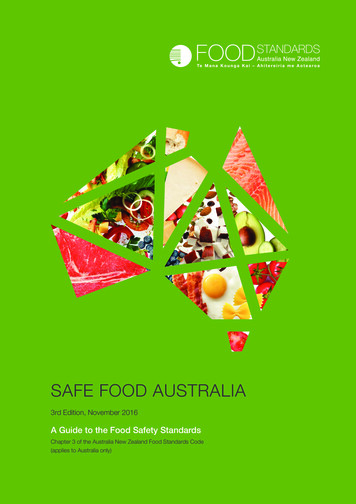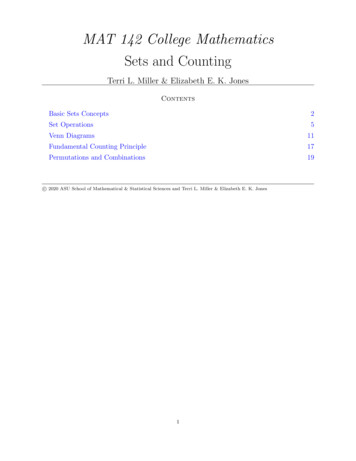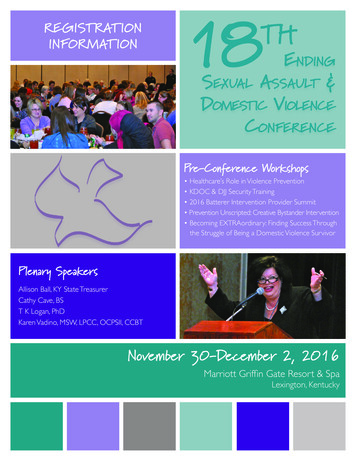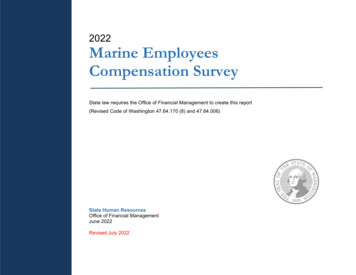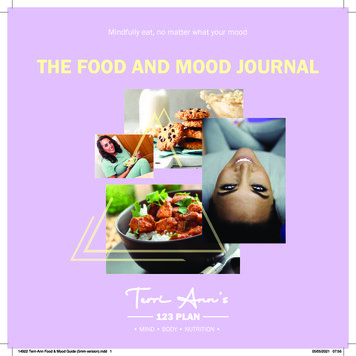
Transcription
Mindfully eat, no matter what your moodTHE FOOD AND MOOD JOURNALTerri Ann's123 PLAN MIND BODY NUTRITION 14922 Terri-Ann Food & Mood Guide (5mm-version).indd 105/05/2021 07:56
2The TerriAnn Food & Mood Guide14922 Terri-Ann Food & Mood Guide (5mm-version).indd 205/05/2021 07:56
Improving yourdiet may help to:Improve your mood,give you more energyand help you thinkmore clearly.Introduction04My Story04This Guide06How To Use This Guide07Food and Mood08Being Mindful16Supportive Friend17My Story18The Change Journey19Where Next? What’s My Destination?21Help Along The Way23Terri-Ann’s Exercise Tips24Terri-Ann’s Guide to Habits27Terri-Ann’s Journey Affirmations28In Loving Memory29Food & Mood Personal Diaries30Points of Contact84References86Disclaimers87The TerriAnn Food & Mood Guide14922 Terri-Ann Food & Mood Guide (5mm-version).indd 3305/05/2021 07:56
IntroductionMy name is Terri-Ann Nunns, I’m a mum of fourchildren and the founder of TerriAnn Diet Plans.For many years I have suffered with my mentalwellbeing, which I feel had a massive impact onmy relationship with food.Iknow from my experience with moodand how it relates to food, and fromsupporting thousands of mymembers, I’m not alone in saying thatour mental wellbeing can influenceour mind-set when it comes to weightmanagement and exercise.Over the years, I have tried andtested so many different techniquesto try and overcome my own mindset when it comes to eating andwhile not every technique workedpermanently, they still made a positiveimpact on my personal healthy eatingand weight loss journey.When it comes to food and mood, there might notbe a ‘one technique fits all’ approach, but there are somereally positive, practical, helpful techniques that I haveused along the way, and that I can share with you.By using this guide, you’ll begin to understand that you’renot alone when it comes to your mental well-being andyour relationship with food. This guide was inspired by myown personal struggles with food and my mood; and mydesire to help others who are facing similar challenges.4My StoryEver since I was around 18 years old I’vestruggled with my weight. I always thoughtof food as a comforting friend, especiallywhen I was stressed or upset. I was aperfectionist, and when things weren’tperfect, I became anxious and wouldconstantly snack and eat large portionsat mealtimes to make myself feel fulland content.I obviously didn’t havegood eating habits.I first realised I was out ofcontrol after the birth ofmy twins, unfortunatelymy baby girl passedaway at birth andthis was a reallyhard time in my life.I had already gaineda massive 5 stoneduring my pregnancyand after slumping intoa depressive state, I nowsought comfort in food andI could not stop myself frombinge eating.I craved junk and would eat anything thatwas high in carbs and fats. I was disgustedthat I couldn’t stop myself from puttingso much food in my mouth. I would easilyexceed 3,000 to 5,000 calories a binge.Sometimes far more. I felt out of controlin so many different ways. I knew Ihad a problem, but didn’t know how tostop myself.The TerriAnn Food & Mood Guide14922 Terri-Ann Food & Mood Guide (5mm-version).indd 405/05/2021 07:56
11 months after the birth of my twins, I had a second baby, a littlegirl, and while I was so happy, I was extremely overweight. I wasalways tired, and I struggled to run after my 11 month old son andlook after my baby girl.Binge eating hurt me physically and mentally. I struggled withmy weight, which made me also try diet tablets and reallyrestricting what I ate during the day. Unfortunately, theseonly made my binge eating episodes worse. Mentally, I feltembarrassed and depressed. I did not want to talk to anyoneelse about my problem.My binge eating and continual search for a solution went on foryears and my weight would fluctuate by 1-2 stones each year.Then, one day when I was so down and unhappy about my weight,I was sick of feeling sorry for myself and making excuse afterexcuse, and I realised that the excuses weren’t going to changeanything and make me happier. It was at this point I seriouslydecided to do something about it:I was going to lose this weight once and for all.I decided to write down all the foods I loved and how they mademe feel I then thought about all the weight loss programs I hadfollowed and how they made me feel. Over a period of 5 months, Icreated an action plan using my thoughts and feelings from everyweight loss plan I had tried and the food I ate. This guide helpedme not only lose weight, but stopped my binge eat cycle and I reached my goal weight!For around seven years I was able to control my binge eating usingthe plan I created, which is now called The TerriAnn 123 Diet Plan.Unfortunately, my binge habits have recently started to return;after a lot of stress and the loss of my dear Nana, my eating wasspiralling out of control once more.I knew I needed a new strategy to get myself back on track so,alongside my diet plan, I decided to put together this food andmood guide which is full of great advice, as well as try somemeditation techniques. Meditation is teaching me to be mindful to remember to live in the moment and to create happiness fromwithin myself again.I am also reading this guide daily I’m putting the knowledge I’ve acquiredinto practice, and the helpful strategiesincluded in this guide have reallyhelped me get back on track with myeating habits.I hope this guide and my story can helpand inspire anyone out there with similarfood and mood challenges.Love,Terr-Ann Nunns xxThe TerriAnn Food & Mood Guide14922 Terri-Ann Food & Mood Guide (5mm-version).indd 5505/05/2021 07:56
This GuideThis guide is intended to help you better understand your relationship with food;in particular how your mood can influence eating patterns, and vice versa.This guide sharessome ideasabout howyou might develop ahealthier relationshipwith food and aims tosupport you in identifyingchanges that could bepersonally beneficial toyou. This guide has beendeveloped by Terri-Ann,a specially chosen teamof Psychologists (sections2-11) and a Dietician.6You are invited toread on if you thinkthis guide could behelpful to you.The TerriAnn Food & Mood Guide14922 Terri-Ann Food & Mood Guide (5mm-version).indd 605/05/2021 07:56
How To Use This GuideThis guide will help you understand and identify the link between how you feeland what you eat, and it will give you the opportunity to really think about howthis applies to you.This guide also uses examples to help explain key points. Throughout the guide, youwill also see a number of symbols linked to activities you are invited to do, including:Mood & Food KeyTAKE A PAUSEThese activities have been included for a number of reasons. Firstly, toprovide space for you to think about how the information in this guide mayapply to you and the challenges you face. Also, to provide encouragementand help you think about, and act on, changes you think could be helpfulfor you to make. For example, many people find writing things downhelpful when it comes to planning, making and maintaining changes.LET’S START AS WE MEAN TO GO ON:BRING TO MIND ASUPPORTIVE FRIENDWhat are your reasons for reading this guide?Make a note of these reasons.MAKE A NOTESOMETHINGTO CONSIDERThe TerriAnn Food & Mood Guide14922 Terri-Ann Food & Mood Guide (5mm-version).indd 7705/05/2021 07:56
dooM&dFooThere are many factors shaping why andwhat we eat, some examples include:We are hungryTo celebrate an occasion(e.g. a birthday)Out of boredomFrom these examples alone,it is clear that food can servemany purposes, and many ofus learn such purposes from a very youngage. Even as young as babies, milk isused as a way to calm and soothe. It is nowonder then that our relationship withfood is so tricky!In particular, many people use food as away to improve how they feel, such as whenthey feel low in mood. At some point in ourlives, most of us will be able to remember atime when we have done this. We may evenhave certain foods which we tend to go forto provide the most pleasure/comfort. So, let’sbe clear, if this is something you are currentlystruggling with, you are not alone!8Family preferences/traditionsFor pleasureFor comfortTo make matters trickier, what weeat can then impact on how wefeel physically and emotionally. Let’sthink about an example; Mary has hadanother bad day at work and is feelingwell and truly fed up and in need of apick me up.Terri-Ann xThe TerriAnn Food & Mood Guide14922 Terri-Ann Food & Mood Guide (5mm-version).indd 805/05/2021 07:56
Feelingfed upViciousI shouldn’t Cyclehave eatenthat.In this example we can see that eating for comfort isfollowed by Mary being hard on herself about havingsnacked/overeaten; this results in her feeling guiltyand a further decline in mood. This may lead to Maryseeking further comfort in food and so the cyclecontinues. Overtime, this pattern is likely to lead toweight gain, reduced mood and a negative view ofherself and her relationship with food.BoredSnack/overeatComfortGuiltIt can be useful to become more aware of how yourmood affects what you choose to eat and the timeswhen this is more of a problem for you (e.g. factorsimpacting on your mood). Read on to learn moreabout this.The TerriAnn Food & Mood Guide14922 Terri-Ann Food & Mood Guide (5mm-version).indd 9905/05/2021 07:56
hlteaHltaenMrouytorppuStosFoodIf we feed ourselves with highly processed, high-fat,high-sugar foods of a poor nutritional quality, weend up over-fed but under-nourished as so muchof that kind of food is energy-dense and nutrient-poor. As foodmanufacturing has progressed over the years, calories haveincreased, but brain-essential nutrients such as B vitamins, zincand magnesium are often ignored. By eating these foods wedon’t only under-nourish our physical health, we under-nourishour mental health too.Mental health is sometimes managed by medication but thereis so much we can do to improve our mental health by simplyadapting our diet. As you read on, you’ll learn more about someof the nutrients that are linked with improving mental health so,take the time to reflect on your current diet and let’s think howyou can incorporate some of these foods into your diet.5-a-day10ProcessedFoodFruit and vegetables have beenlinked to improved mentalwellbeing, which further supportsthe recommendation of achievingat least 5 portions of fruit andvegetables per day. A portion is 80g,so a small handful of fruit or 2-3 tbspvegetables. Remember that driedfruit is 30g and you can also have a150ml glass of fruit juice for anotherportion so it’s far easier for youto achieve your 5-a-day than youmay think.The TerriAnn Food & Mood Guide14922 Terri-Ann Food & Mood Guide (5mm-version).indd 1005/05/2021 07:56
Omega-3 fatty acids are anotherimportant nutrient when it comes tomental health. Inadequate intake ofomega-3 has been linked to depression,poor concentration and memoryproblems. Omega-3 has also beenlinked to improved cognitive functionand reduces risk of cognitive decline,so the way in which our brain works, aswe get older. The best dietary source ofomega-3 is in oily fish such as salmon,mackerel and sardines. Omega-3 fattyacids are also found in walnuts andflaxseeds but if you don’t consumeoily fish, you may wish to take a dailyomega-3 supplement of EPA and DHA(look on the label).Thiamine or Vitamin B1 is thought toplay a role in mood regulation so couldhelp to balance your mood, helping toprevent unwanted dips. Studies haveshown people with a high thiaminestatus become more clearheaded,composed and energetic. Goodsources of thiamine include flaxseeds,wholegrain bread, fortified breakfastcereals, eggs and peas.An insufficient folate intake has beenassociated with poor mood and lowenergy levels, with folate deficiencybeing linked with higher levels ofdepression. Including folate-rich foodsin your diet such as broccoli, asparagus,chickpeas and spinach may help toreduce the risk of depression andimprove energy levels.Similar to folate, low levels of zinc has also been linked toincreased levels of depression, and studies suggest that higherintakes of zinc could help in the management of depression.So, including zinc-rich food sources such as meat, oysters, dairyproducts and nuts, could help to improve mood and protect yourmental health.And an easy one to incorporate into your daily life is water.Studies have shown that increasing your water intake can reducethe risk of both depression and anxiety. And, drinking water is ahabit that is so easy to put in place and could have a noticeableeffect on how you feel.How much water do you drink eachday? Could you drink more?We are always told how eating more or less of certain foodsmay reduce our risk of diabetes, heart disease or cancer, butit is rarely discussed that eating a healthy, well-balanced dietprotects our mental health too. But now you know, so listen to itand act on it! If you are unsure whether you consume enough ofthese vitamins and minerals you could take a multi-vitamin andmineral supplement, but if you follow healthy eating principlesand reduce the amount of nutrient-poor junk and conveniencefoods in your diet then this can significantly improve yourmental health.The TerriAnn Food & Mood Guide14922 Terri-Ann Food & Mood Guide (5mm-version).indd 111105/05/2021 07:56
The 80:20 rule.is a very good rule to live by as it encouragesbalance and creates a sustainable way to behealthy. What it means is that 80% of the timewe should eat healthily and make healthylifestyle choices, but 20% of the time wedon’t have to follow the rules so we can havethat chocolate bar we wanted, we can have anoccasional takeaway, we can have analcoholic drink, and that’s OK!Healthy LifestyleChoicesHave youcome across the80:20 rule?OccasionalTreatsIt would be incredibly difficult to eat and live healthily100% of the time and would normally result in eithera relapse or binge-eating, meaning our weight goesback up to where we started and often higher! So,the best way to eat and live healthily is by allowingyourself to have those occasional treats and foodsthat you enjoy as part of your diet and not feelingguilty about having them!12The TerriAnn Food & Mood Guide14922 Terri-Ann Food & Mood Guide (5mm-version).indd 1205/05/2021 07:56
Feeling down and wantto reach for the biscuit tin?Don’t be afraid to seek thesupport of a friend.Get together for a cuppaand tell her how you feel.it’s good to talk.The TerriAnn Food & Mood Guide14922 Terri-Ann Food & Mood Guide (5mm-version).indd 131305/05/2021 07:56
Hunger ScaleAgood principle to help us to manage ourfood intake without counting caloriesis by thinking about your hunger scale.The hunger scale is an intuitive eating principleand has been adapted in several ways. It is aneffective strategy that makes us more mindful andtunes us into our hunger and fullness cues.Imagine a scale of 0-10. 0 is when you areabsolutely starving and 10 is when you can barelymove because you are so full. We can all agree thatwe never want to be in either of these places.If we don’t eat, either through choice or poor planning,leading to us feeling starving, we stop thinking mindfully andeating mindfully. If we are in a restaurant, we might order a starter,main and desert, if we’re cooking ourselves a meal at home we maycook a large portion and have snacks whilst we cook because the mindful switch has gone off. At theother end of the scale, if we eat to the point we feel we can barely move, feel sick or are in pain we couldhave had up to double the amount of food we should have had – which is not ideal if we are trying tomanage our weight. We feel sluggish and de-energised afterwards and are left with feelings of guilt andregret. If we know this is how we would feel, why do we do it in the first place?On the hunger scale, a good place to stay within is between a 3 and a 7 at all times. This way you willnever experience each end of the scale and you will feel in control at all times.How to stay between 3 and 7:Plan aheadDrink plenty of waterHave 3 meals every dayListen to your hunger and fullness cues don’t ignore themHave healthy snacks if required14The TerriAnn Food & Mood Guide14922 Terri-Ann Food & Mood Guide (5mm-version).indd 1405/05/2021 07:56
Painfully HungryRavenous –Very DistractingPainfully Full10UncomfortablyFull98Little BitToo Full2HungerFullness Scale7ComfortablySatisfied1Very HungryEager To Eat6Slightly FullStomach34Hungry, ButNot StavingSlightly EmptyStomach5Neutral –Not Hungry orFull1514922 Terri-Ann Food & Mood Guide (5mm-version).indd 1505/05/2021 07:56
A Healthy Relationshipwith Weighing ScalesPeople have different relationships with weighing scales.Weighing scales are friends to some people and enemiesto others, but in reality, they are just weighing scales!Think about your relationship with your weighing scales Howdo they make you feel before and after you step on them? If youexperience negative emotions with weighing scales, perhaps youneed to change the way you use them or just not use them at all.If you weigh yourself multiple times a week, every day or evenmultiple times a day, putting pressure on yourself to lose weight,you are probably doing more harm than good. If you choose touse scales to monitor your progress or ‘check-in’ with how you’redoing, that is fine, but consider a frequency of around once perweek. Also, remember that standard scales don’t tell us everythingrelevant when it comes to weight loss; they don’t tell us how muchfluid we have on board, they don’t tell us whether it is the time ofthe month, they don’t tell us if we have been to the toilet recently,they don’t tell us if our muscle mass has increased because we’vebecome more active. So, if you do use weighing scales, use themas a guide but remember, there are a lot of other factors that canaffect the weight you see on the scales.Of course, there is always the option to not even use weighingscales at all. You can be guided by clothes size, energy levels,how you feel, mobility, physical ability, as these are all importantmarkers to be aware of when making healthy lifestyle choices. And,if you choose not to use weighing scales this is absolutely fine!Think about your journey and what is going to work for you.16Being MindfulFor many of us, the link betweenhow we feel and what/how weeat can go unnoticed; over timewe can get into patterns/habits ofbehaving. If we think about Mary’sexample again; over time Mary mayassociate snacking/certain foodswith feeling better, so each timeshe gets upset, she may reach forfood to feel better without eventhinking.In order to understand yourrelationship with food and whatchanges may be helpful, it isimportant to become more mindfulof your thinking, feelings andbehaviours around your eatingpatterns. This involves taking apause, noticing what is goingon in your mind and body andmaking choices based on carefulconsideration of what will behelpful to you and your life ratherthan making choices on impulseor through habit. You will soonnotice that being more mindful caninfluence how much you eat andthe enjoyment you get from whatyou are eating.This guide invites you to do thisthroughout this guide , but alsoto include these pauses in youreveryday life.The TerriAnn Food & Mood Guide14922 Terri-Ann Food & Mood Guide (5mm-version).indd 1605/05/2021 07:56
A Supportive FriendIt is easy to see how Mary and many of us can get caught up in unhelpful patterns/cycles with food. As you can see from Mary’s example; the critical judgements wemake about ourselves and our actions can further fuel these cycles.Take a momentto consider:Why is it we can generally offerother people more understandingand kindness than we show toourselves?Developing the ability to bemore understanding and kinderto ourselves is important inexploring our relationships withfood and mood and in makingchanges. In fact, it can help us infacing other challenges we meetin everyday life too.Bring to mind a supportive friend.What do they do, or could theydo, to make you feel supported?If it is difficult to bring to mind asupportive friend, try to visualisein your mind what one may looklike and how they may act.If we had a friend facing a particularchallenge, would we offer criticismor support? (It’s more likely to bethe latter).You might like to name this person and write down what it is aboutthem and what they do which makes/could make you feel supported.As you continue to read through this guide, you will be invited to thinkabout this friendas a way of supporting you on your journey inaddressing your relationship with food and your mood.You may even want to ask this friend to go through this guide with you.The TerriAnn Food & Mood Guide14922 Terri-Ann Food & Mood Guide (5mm-version).indd 171705/05/2021 07:56
My storyHow does my mood affect what/how I eat?What are my triggers to overeating/snacking?How do I feel during and after reaching for food?How is this pattern working for me?It may be useful to write this informationdown; this information may be helpful to youwhen it comes to thinking about/planning how tobreak unhelpful cycles between how you think andfeel about your eating patterns.18Bring to mind yoursupportive friendSome people find ithelpful to keep a diary overa week or two to help thembetter understand the linkbetween their mood and food.The TerriAnn Food & Mood Guide14922 Terri-Ann Food & Mood Guide (5mm-version).indd 1805/05/2021 07:56
The Change JourneyThe change journey can feel likea bumpy one. Making changes inlife, whatever they may be, arerarely easy! I’m sure most of us can recallchanges we have made that have gonewell and those that we have struggledwith. Feeling low can make it seem evenmore difficult to plan, make and stick tochanges.Asking for help doesn’t meanyou weak, it means your wise.It may be useful to write your reflections down; thisinformation may be helpful in supporting any futurechanges you plan to make.It can be really easy to criticise ourselvesfor this and label our efforts as just‘another failed attempt’ or to think ‘it willnever work’. It can be helpful to remindourselves that change takes time and thatsetbacks are a normal part of the changeprocess; in fact, you can – and will – learna lot from these setbacks.Bring to mind changes youhave made/attempted in thepast and think about:What went well?Why might that have been?What did not go to plan?Was there any learning from this?How did these changes make adifference to me?Much research has been done on how people change; the Stagesof Change Model (Prochaska & DiClemente) provides a way ofunderstanding the stages we go through when making changes.Readiness for change can vary overtime – and can depend onthe change in question; it is very normal to go up and downthe stages, with relapses being a normal part of this process.In fact, many people will relapse many times before being ableto maintain changes.The TerriAnn Food & Mood Guide14922 Terri-Ann Food & Mood Guide (5mm-version).indd 191905/05/2021 07:56
seFall back to oldpatternsnRela pIt may be helpful tomake a note of this.Preconte mplatioStages ofChangeionratActi onWhat change(s) do I want to make?If you have identified more than one change,consider which stage you are currently in foreach of these.20PPlanning tomake changesparePutting plansinto actionConsideringchange toaddress Not thinkingabout changeAlthough it is clear that making changes can betricky business, particularly when people arefeeling low, the good news is that people can anddo make changes! In fact, you are already makinga change by reading this guide/seeking supportin this area. Read on if you want to make a planfor where to go next.The TerriAnn Food & Mood Guide14922 Terri-Ann Food & Mood Guide (5mm-version).indd 2005/05/2021 07:56
Where Next. . What’s my Destination?This guide has sharedinformation about why ourrelationships with food andmaking changes in this area can be sotricky; particularly in relation to ourmood when it comes to food. This guideinvites you to think about your ownrelationship with food and what youcan learn along the way when it comesto making changes in your life.It is important to identify your goal(s) and the steps involved inworking towards these – as well as making a clear plan for this. Doingso will ensure that your goals feel more manageable and achievable.It may be helpful to imagine this as being like climbing a staircase;with each step taking you closer to your goal. For example:This guide has identified howdeveloping a more understanding andkinder way of approaching yourselfand the challenges you face, alongsidea more mindful way of being, can helpyou in exploring problems and possibleways forward from these. Movingforward, this guide can help you puttogether a plan for the change(s) youwish to make.STEP 3: Go swimming once a week (Thurs at 6pm at.)There can often be a number ofchanges linked to a particular goal; forexample, for someone wanting to loseweight, a number of changes in thefollowing areas could be helpful:Dietary changesGoal: To swim 3 times a weekSTEP 1: Research local swimming poolsSTEP 2: Find/buy swimwearSTEP 4: Build up to twice a week (Tues & Thurs at 6pm at.)STEP 5: Three swimming sessions (Your ideal days and times at.)Making a note of your goals,and how you are getting on isreally useful as doing so canhelp you to monitor and buildon your progress, celebrate yourachievements and problem solveany barriers that come up.Increasing activity levelsGetting support around making,and maintaining, changes2114922 Terri-Ann Food & Mood Guide (5mm-version).indd 2105/05/2021 07:56
andWhere would bea good place foryou to start withthe change(s) youwant to make?How will anychanges youmake improveyour health andwellbeing?How will youmonitor yourprogress?If not, whatare the reasonsfor this?22Please use the areabelow to make noteswhen considering these questions:What steps doyou need to taketo achieve yourgoal?Are there are anybarriers to makingyour chosen changesand how will youmanage these?Do you feel ina position tomaking changesat this time?What else doyou need to doright now?The TerriAnn Food & Mood Guide14922 Terri-Ann Food & Mood Guide (5mm-version).indd 2205/05/2021 07:56
Help Along The WayAt different times in our lives we all need help along the way; there is no shame inthis, in fact, it can take a lot of courage to ask for help/support. This could be supportaround your mood or around lifestyle factors such as your diet and activity levels.Talking to a family member, friend orhealthcare professional such as your GPcan be helpful when it comes to getting anyadditional support you need, or even in just helpingyou think about what support you may need and howto access this.Consider:Do you need any support at this time?What would this look like?Who could provide this?How can you access the support you need?It is important to build this informationinto your plan.Make a note of what support, if any, is needed, andhow this fits with your plan for moving forward.The TerriAnn Food & Mood Guide14922 Terri-Ann Food & Mood Guide (5mm-version).indd 232305/05/2021 07:56
Terri-Ann’sExercise TipsIknow personally that, when you are in lowmood, exercise often seems like the last thingyou want to do. But once you get motivated,exercise can make a big difference to how you are feeling.Not only can exercise help and improve physical problemssuch as high blood pressure, diabetes and arthritis, researchhas found that exercise can also help improve mood andmental wellbeing.Lots of people find that by working out or doing other forms of physical activity, they have been able toimprove their mood and, in turn, they notice that it makes them feel better in themselves.24Regular exercise mayhelp ease depressionand anxiety by:REGULAR EXERCISE HAS MANY PSYCHOLOGICAL AND EMOTIONALBENEFITS, TOO. IT CAN HELP YOU: releasing feel-goodendorphins and other naturalbrain chemicals that canenhance your sense ofwell-being.Get more social interaction. Exercise and physical activity may give youthe chance to meet or socialize with others. Just exchanging a friendlysmile or greeting as you walk around a park or gym can help your mood. helping take your mind offworries, so you can get awayfrom the cycle of negativethoughts.Improve your mood. Exercising isn’t just about going to the gym andfollowing a class, any physical activity that gets you off the sofa andmoving, such as regular walking may help improve mood and help youfeel better.Gain confidence. Meeting exercise goals or challenges, even small ones,can boost your self-confidence. Getting in shape can also make you feelbetter about your appearance.Feel more positive. By you doing something positive to try manage yourmental wellbeing, you’re actually adopting a healthy coping strategy.The TerriAnn Food & Mood Guide14922 Terri-Ann Food & Mood Guide (5mm-version).indd 2405/05/2021 07:56
Just remember You don’t have to do all your exercise or otherphysical activity at once. Take small steps! Findways to add small amounts of physical activitythroughout your day. For example, take thestairs instead of the lift. Park a little furtheraway from work to fit in a short walk. Or, if youlive close to your job, consider biking to work.How much should I do?Doing 30 minutes or more of exercise a day forthree to five days a week will help with yourmental wellbeing. But even smaller amounts ofphysical activity – as little as 10 to 15 minutesat a time – can make a difference. It is also worthnoting that it may take less time exercising toimprove your mood when you do more vigorousactivities, such as running or bicycling.The mental health benefits of exercise andphysical activity may last only if you stick withit over the long term – another good reason tofocus on finding activities that you enjoy.How to introduce exerciseand stay motivatedIntroducing exercise
Terri-Ann's Exercise Tips 24 Terri-Ann's Guide to Habits 27 Terri-Ann's Journey Affirmations 28 In Loving Memory 29 Food & Mood Personal Diaries 30 Points of Contact 84 References 86 Disclaimers 87 Improving your diet may help to: Improve your mood, give you more energy and help you think more clearly. 14922 Terri-Ann Food & Mood Guide .





